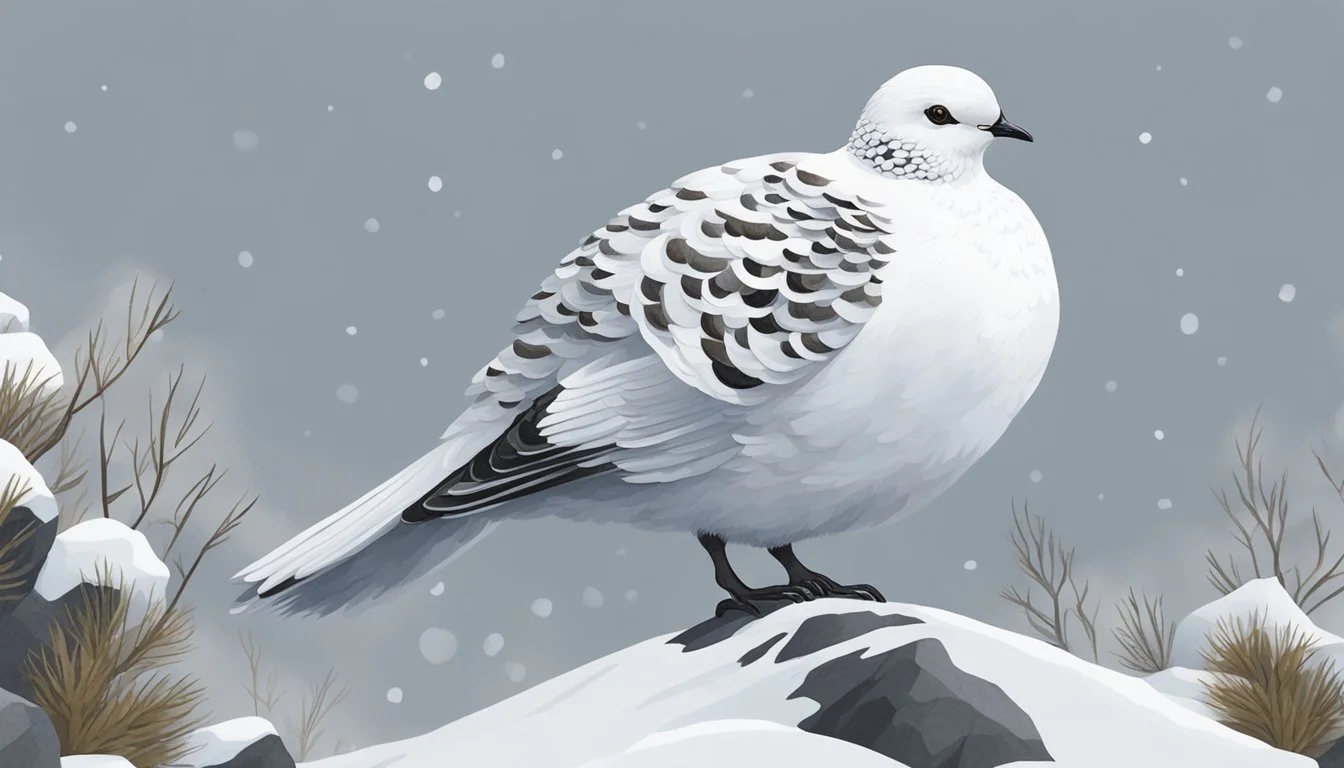Ptarmigan Hunting Seasons
Regulations and Peak Times Revealed
This Article is Part of Our Guide on Hunting Seasons for Over 70 Common Game Species
Ptarmigan hunting is a practice steeped in tradition, with enthusiasts taking to various terrains in pursuit of these game birds. The ptarmigan, a bird well-adapted to alpine and Arctic environments, is often sought after for its challenge and the unique hunting experience it offers. Hunting regulations for ptarmigan, such as season dates and bag limits, are established by wildlife agencies to ensure sustainable populations. These regulations vary widely by region, reflecting the differing ecosystems and ptarmigan behaviors in areas like Colorado and Alaska.
In Colorado, for example, the hunting seasons for ptarmigan are notably short and restricted to specific geographic units, a reflection of the bird's habitat needs and population status in the region. Contrastingly, Alaska offers a much longer hunting season for these birds, reflecting their greater abundance and the state's larger expanses of suitable habitat. Hunters must be aware of the local regulations, such as daily bag and possession limits, which can vary significantly between areas. Some regions in Alaska even permit the use of traps or snares for hunting ptarmigan, indicating a more permissive approach in line with the state's robust ptarmigan populations.
Hunters pursuing ptarmigan must prepare for the challenging conditions typical of the birds' habitats. Female and male ptarmigan tend to separate during the autumn months, with males often remaining at higher elevations while females move to lower elevations in search of food and shelter. This behavior pattern can affect hunting strategies and success rates. Knowledgeable hunters understand the importance of respecting seasons and limits to preserve the tradition of ptarmigan hunting for future generations.
Ptarmigan Species Overview
Ptarmigan, members of the grouse family, are hardy birds distinguished by their adaptation to cold environments and seasonal plumage changes. This section examines their physical characteristics, varied species and their range, as well as their preferred habitats and ecological roles.
Physical Characteristics
Lagopus lagopus, commonly known as ptarmigan, undergo remarkable changes throughout the year. Adults typically grow to an average length of 38-43 cm, boast a wingspan of 51-57 cm, and weigh around 590 g. The most distinctive trait is their plumage, which alters color from mottled brown in summer to pure white in winter, aiding in camouflage against the snow.
Species and Range
Ptarmigan are categorized mainly into three species:
Willow Ptarmigan: These birds are predominantly found throughout Alaska and parts of Northern Canada, often lining willow-fringed waterways.
Rock Ptarmigan: Found on tundra slopes and high valleys across Alaska, they have a preference for higher, drier, and rockier ground compared to their willow-dwelling cousins.
White-tailed Ptarmigan: Occupying the young mountain ranges of southcentral and southeastern Alaska, these birds also extend into montane regions as far south as Colorado, living almost exclusively above timberline.
Each species has its unique breeding areas and population densities influenced by the local climate, food availability, and human development.
Habitat and Ecology
Ptarmigan favor habitats that range from the coastal plains to the subalpine and alpine regions of the tundra. They often select environments that include:
Willow Ptarmigan: Tall willow bushes, particularly around waterways.
Rock Ptarmigan: Patchy shrubs intermingled with low herbs and grasses on rockier terrain.
White-tailed Ptarmigan: Boulder fields, snowfields, and glaciers well above the timberline.
In terms of ecology, these birds are key in their respective ecosystems. Their breeding success and population dynamics are indicators of environmental health, and they respond quickly to changes brought about by climate change and human activity. Conservation efforts are essential to sustain healthy populations, as ptarmigan play a significant role in the food web and the overall balance of their habitats.
Understanding Ptarmigan Hunting
Ptarmigan hunting offers an engaging experience due to long seasons, ample bag limits, and the distinctive environments where these birds thrive. This section explores the important aspects of ptarmigan hunting, including the legal framework, hunting methods, and the use of hunting dogs.
The Hunting Season and Legal Framework
The hunting season for ptarmigans can be extensive, often encompassing most of the year. Regulations vary by region, with areas around Anchorage allowing hunters to take up to 10 birds a day, while other locales may permit up to 50 birds daily and 100 in possession. Beyond daily limits, hunters must ensure they have the necessary habitat stamp and adhere to specific days when hunting is permitted. For instance, certain regions may exclude hunting on Wednesdays and Thursdays to facilitate population control and habitat recovery.
It's imperative for hunters to stay informed about the local regulations as they can fluctuate yearly and by jurisdiction. A valid hunting license and awareness of the regional laws are essential to ensure a lawful and ethical hunting trip.
Hunting Techniques and Gear
Ptarmigan can be hunted using various techniques, including trapping, snaring, or traditional hunting with a shotgun. While a 20-gauge shotgun is commonly used for upland bird hunting, some hunters may opt for lighter or heavier gauges. Hunters often traverse challenging terrains, making snowshoes or good-quality boots essential, especially during winter hunts.
Gear Item Utility Shotgun Essential for taking down ptarmigan Snowshoes Vital for navigation in snowy terrain Camouflage Helps blend in with the environment Bird Vest Storage for ammunition and harvested birds
Visibility on a hunting trip is crucial; thus, camouflage attire appropriate to the season and ptarmigan habitat is recommended to avoid detection. Additionally, a bird vest can aid in carrying ammunition and the harvested birds with ease.
The Role of Hunting Dogs
Although hunting dogs are not a necessity in ptarmigan hunting, they can certainly enhance the experience by locating and retrieving the game. Ptarmigans are known not to be especially wary of humans or dogs, which can be an advantage during a hunt.
Dogs specialized in upland bird hunting are trained for these tasks, with breeds like the Pointer or Setter being popular choices. They use their keen sense of smell to find ptarmigan and can be trained to gently retrieve the birds after they are taken down.
Hunters may decide to hunt with or without a dog based on preference, the terrain, and the hunting regulations of the area they are hunting in. Nonetheless, many hunters appreciate the companionship and aid that a hunting dog provides during their excursions.
Ptarmigan Hunting by Location
Ptarmigan hunting regulations vary significantly by location, with differences in season duration, bag limits, and hunting methods. Hunters must consult local guidelines to ensure compliance with current regulations.
United States
In the United States, ptarmigan hunting is notably popular in Alaska, where regulations are often more permissive compared to other states. For instance, near Anchorage, hunters may take up to 10 birds a day, while in more remote areas, the limits can increase to 50 birds per day with a possession limit of 100. Hunting methods also include the use of traps and snares in designated regions.
Moving south to states like Colorado, the white-tailed ptarmigan can be found in alpine habitats, and hunting seasons are typically established to align with the bird's life cycle. As ptarmigan change their plumage to white in winter seasons to blend with the snow, their visibility to hunters may decrease.
States such as Washington, California, Nevada, and Montana do not have established hunting seasons for ptarmigans, as the birds are uncommon or absent in these areas. Meanwhile, states like Utah offer opportunities to observe and potentially hunt white-tailed ptarmigan during the spring to fall when they display their mottled brown-gray coloration. States where ptarmigan are not present, such as Kansas, Michigan, and Virginia, obviously have no hunting season for them.
Canada and Iceland
In Canada, ptarmigan hunting is generally regulated at the provincial level, and the habitats where these birds are found are often in northern and alpine regions. Specific details about seasons and bag limits will vary across provinces, so hunters need to review the areas they plan to hunt in for species presence and provincial regulations.
Iceland offers a contrast with its own unique practices and traditions for ptarmigan hunting. Iceland does not impose a general bag limit similar to Alaska's most liberal regulations, allowing hunters to participate in the season with no set limits on the number of ptarmigans they can harvest, though certain days may be excluded from hunting each week.
In both Canada and Iceland, as well as in northern parts of the United States like Alaska, ptarmigan habitats span across tundra and mountainous areas. The birds' plumage adapts with the changing seasons, providing them with camouflage against predators and, by extension, a dynamic challenge for hunters.
Ptarmigan Behavior and Seasonal Changes
Ptarmigan exhibit distinct behaviors and adaptations throughout the year, adjusting to seasonal changes for survival and reproduction.
Breeding Season and Mating
During the breeding season, ptarmigan behavior is focused on reproduction. The males become territorial and perform elaborate courting displays to attract females. Females lay their eggs in shallow ground nests, which are protected by the surrounding vegetation. The eggs, usually between 6 to 14 in a clutch, are incubated primarily by the females for about three weeks. After hatching, chicks join their mother almost immediately, as they are precocial and able to forage for food.
Families of willow ptarmigan join to form larger flocks as the end of the breeding season approaches. This usually occurs around September, when they begin to move more and their habitats and behaviors shift in preparation for the winter months.
Winter Survival and Adaptations
Ptarmigan are well-adapted to survive the harsh conditions of winter. They display a remarkable ability to change their plumage according to the season; during winter, their feathers become pure white, allowing them to blend in with the snow and avoid predators. The exception to this is the willow ptarmigan's tail, which remains black. Sportsmen could be aided in spotting ptarmigan in their snowy habitat when the bird's tail contrasts with the snow.
The birds' behavior changes as they seek shelter and food at lower elevations. Those ptarmigan found at higher altitudes may dig into the snow to create insulated roosts that conserve body heat. They predominantly feed on twigs, buds, and leaves of willow and birch, with the composition of their diet varying slightly depending on local plant availability. As the winter advances, ptarmigan may grow feathers on their feet, functioning like snowshoes to support them on the snow's surface.
Hunting Regulations and Conservation
Proper understanding of hunting regulations and conservation strategies is essential for preserving ptarmigan populations while providing hunting opportunities. Regulations are put in place not only to manage the hunting activities during specific seasons but also to ensure sustainable population levels.
Regulation Details and Season Dates
Regulation of ptarmigan hunting is subject to change, but typically includes specific season dates and bag limits to prevent overharvesting. For example, in some regions around Anchorage, hunters may be allowed up to 10 birds per day, with the season running for most of the year. Other areas might permit up to 50 birds per day, with 100 in possession, offering generous opportunities for hunters.
Region Daily Bag Limit Season Duration Anchorage Area 10 birds Most of the year Other Areas Up to 50 birds Most of the year
These limits and seasons are designed to reflect ptarmigan population health and reproductive cycles.
Conservation Efforts and Population Management
Conservation efforts are crucial to sustain game bird species like the ptarmigan. Wildlife agencies monitor populations and adjust regulations accordingly. Conservation measures often include:
Habitat protection: Safeguarding important breeding and feeding areas.
Research: Gathering data on ptarmigan numbers and health.
Predator management: Balancing predator-prey relationships to maintain healthy bird populations.
Active population management ensures that hunting does not adversely impact ptarmigan numbers, allowing for a continued balance between recreational hunting and species conservation.
Additional Upland Bird Hunting Opportunities
In addition to ptarmigan, hunters can explore a range of upland bird species across various regions, each offering unique challenges and regulations.
Upland Species Variety
The diversity of upland bird species affords hunters numerous hunting opportunities throughout different seasons and states. Key species include the blue grouse, known for inhabiting mountainous forests; the bobwhite, a favorite among Eastern and Midwestern hunters; and various types of quail (What wine goes well with quail?), such as Gambel’s and scaled quail, predominantly found in the arid Southwest. Each offers a distinct hunting experience, from the terrain they inhabit to the strategies required for a successful harvest.
Upland Bird Species Preferred Habitat Distribution Blue Grouse Mountainous forests and meadows Western US Bobwhite Grasslands, agricultural fields Eastern, Midwest US Gambel’s Quail Deserts, arid regions Southwest US Scaled Quail Grasslands, brushy areas Southwest US Pheasant Farmlands, grasslands, wetlands Nationwide
Hunting Grouse Family Species
The grouse family of birds, which includes the blue grouse, is a sought-after group for upland bird hunters. They are typically found in a variety of habitats ranging from the dense forests to the high meadows of mountain ranges. Hunting these species demands patience and keen attentiveness, as grouse are well-adapted to their environments and can be elusive. Tactics often involve quiet stalking and quick, accurate shooting once the birds are flushed from cover.
Grouse Species: Blue grouse, ruffed grouse, sharp-tailed grouse.
Typical Habitats: Forests, alpine meadows, prairie landscapes.
Seasons and Regulations: Vary by state and region; hunters should consult local wildlife management agencies for specific dates and limits.
Preparing for Your Ptarmigan Hunting Trip
When embarking on a ptarmigan hunting trip, one must prioritize an effective gear checklist and adhere to stringent safety measures and ethical hunting practices.
Essential Gear Checklist
Clothing:
Thermal layers for warmth.
Waterproof outerwear for variable conditions.
Blaze orange vest for visibility.
Navigation:
GPS device or compass.
Topographical map of hunting area.
Hunting Equipment:
Shotgun: Suitable for upland bird hunting.
Ammunition: Correct gauge and load for ptarmigan.
Snowshoes: To navigate snowy terrain efficiently.
Miscellaneous:
Sufficient food and water for the trip duration.
First aid kit.
Safety Considerations and Ethics
Safety:
Inform someone of your trip itinerary.
Check weather forecasts and be prepared for sudden changes.
Carry a survival kit and know how to use it.
Ethics:
Follow local hunting regulations and season dates.
Practice fair chase principles.
Aim for clean, humane shots to ensure a quick harvest.
Respect the habitat and local wildlife.







